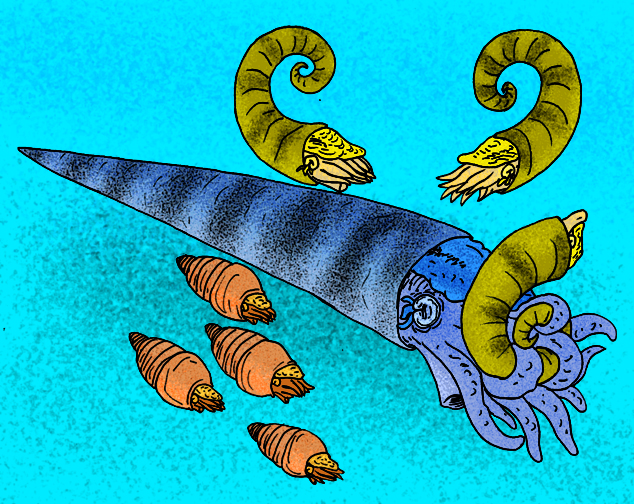- Proterocameroceratidae
Taxobox
name = Proterocameroceratidae
fossil_range =Ordovician

regnum =Animal ia
phylum =Mollusca
classis =Cephalopod a
subclassis =Nautiloid ea
ordo =Endocerida
familia = Proterocameroceratidae
subdivision_ranks = genus
subdivision = † † † The "Proterocameroceratidae" were the first of theEndocerida . They began early in the Ordovician with "Proendoceras" or similar genus which had developed endocones, replacing the diaphragms of the ellesmerocerid ancestor.Proterocamerocerids are long, straight or gently curved with a generally narrow siphuncle along the ventral margin. Septal necks are short, never quite reaching the previous septum and may vary in length ontogenically with in a species. Connecting rings are thick and layered. Endocones are simple, especially in early forms but may be complex with secondary structures in later forms.
The Proterocameroceratidae gave rise to the
Piloceratidae early on, and later to the Manchuroceratidae and Chihlioceratidae, from which the Allotrioceratidae are derived, and later yet possibly to the Emmonsoceratidae and Najaceratidae. The Piloceratidae in turn may have given rise to theEndoceratidae although a proterocameroceratid ancestor remains possible.Proterocamerocerids were probably mobile bottom predators that moved from place to place over the sea floor in search of prey or escape. Their shell was on one hand a carry over from some Cambrian monoplacophoran ancestor, passed on through previous orders, and on the other both a hydrodynamic facilitator and protection. But the shells of nautiloids, such as the proterocamerocerids was also an impediment to true squidy or fishy swimming. They could not have had fins for propulsion or steering, only the hyponome for spontaneous jet mobility and their tentacles by which to crawl across the sea floor and to grasp at things. The diagnostic endocones in the early part of the siphuncle balanced the weight of the animal living at the front of the shell.The Proterocameroceratidae ultimately suffered the extinction at the end of the Ordovician, but not before having given rise to a variety of endocerid families. They remain a subject of interesting research.
References
*Flower, R. H. 1955, Status of Endoceroid Classification; Jour. Paleon. V 29. n.3 May 1955pp 327-370.
* — 1958, Some Chazyan and Mohawkian Endoceratida, Jour Paleon V 32, n 2,May 1858, pp 433-458.
* — 1976, Ordovician Cephalopod Faunas and Their Role in Correlation, pp 531-537 in The Ordovician System: Proceedings of a Paleontological Association Symposium; Univ of Wales and Welsh Nat’l Mus Press.
*Teichert, Curt 1964, Proterocameroceratidae in the Treatise on Invertebrate Paleontology, VolK pp K166 -k170; Geol Soc of America and University of Kansas Press
Wikimedia Foundation. 2010.
